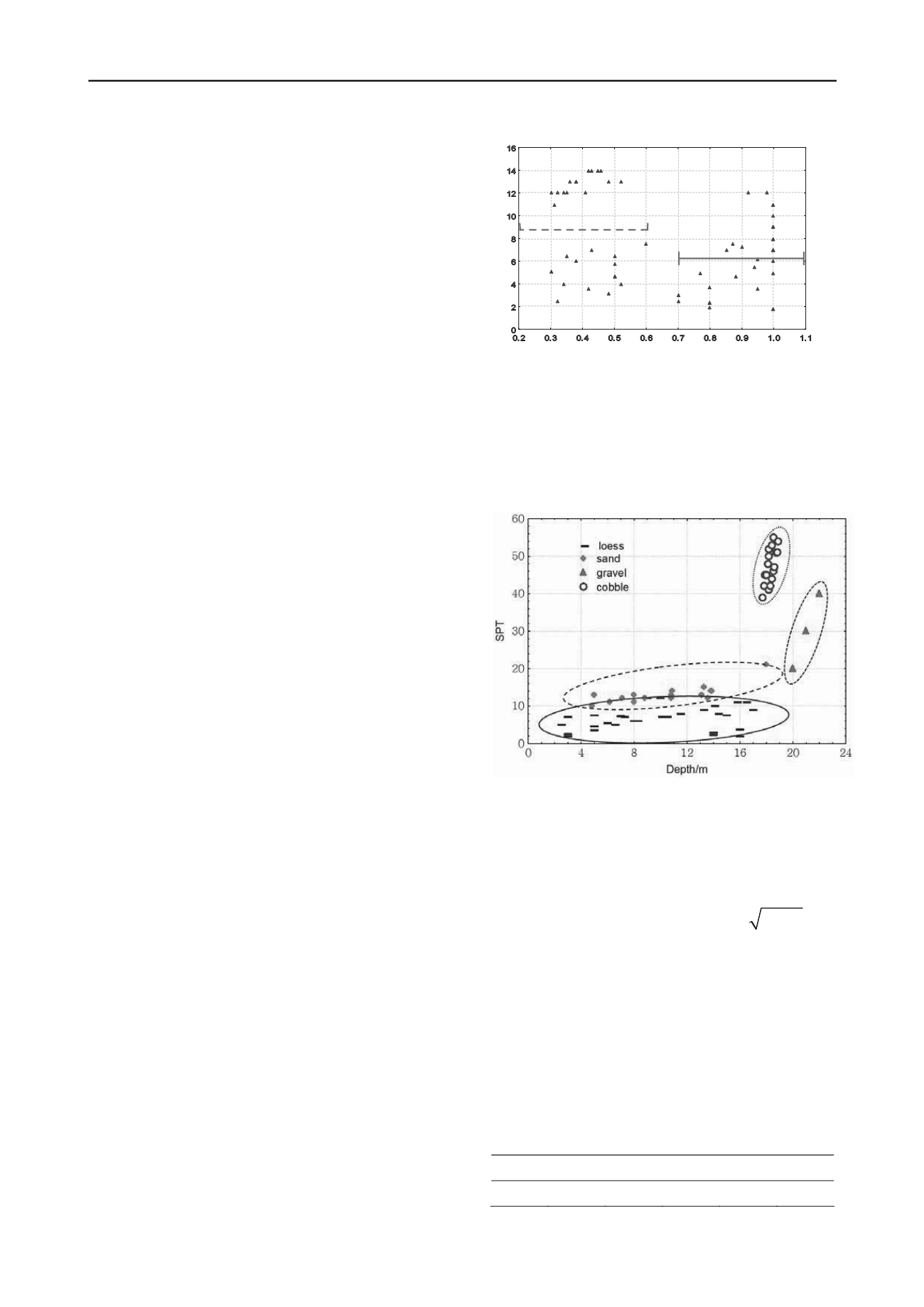
1649
Technical Committee 203 /
Comité technique 203
geotechnical seismic hazard setting, no such recommendation
were made for structure design.
The significance of the La
0
[ln(0.6 1.5) 0.1 ] 3 /
cr
s
w
c
N N
d
d
nzhou code is liquefaction of
loe
4.2 Preliminary evaluation of loess liquefaction in Specification
To up
dopted
tion of loess adopted
1) Saturated new loess (geological age younger than the
tensity of 7, 8 and 9, the
If the saturated loess meets both of the two criteria, it
me as the national seismic code.
Unti
ge of clay content. Hwang and Wang
co
DETAILED LOESS LIQUEFACTION EVALUATION
aluated as liquefiable using the
5.1 SPT of loess sites
alue of loess ground with different degree
ils such as sand and gravel, the
0.2 0.3 0.4 0.5 0.6 0.7 0.8 0.9 1.0 1.1
S
r
0
2
4
6
8
10
12
14
16
SPT
average SPT=6.3
average SPT=9.4
ss is formally introduced as one of the hazard needs to be
considered for seismic design. This provides practical
experience for better evaluation of loess liquefaction and its
treatment. Furthermore, it also laid foundation for incorporate
loess liquefaction in wider region such as Gansu province.
for seismic design of buildings of Gansu province
date seismic design in Gansu province and also a
some of the local conditions and practices, the Gansu
Committee of Construction Experts started draft of new
specification for seismic design in Gansu province. The authors
were involved in draft provisions on loess liquefaction. This
time, a lot of new findings and new methods were discussed,
which results a much mature guidelines for evaluation of loess
liquefaction. The Specification on Seismic Design of Gansu
Province (DB62/T25-3055-2011) (to be referred as Gansu code)
provide much better method for evaluation of loess liquefaction
both in term of reliability and feasibility.
The preliminary evaluation of liquefac
in Gansu code is as follows:
middle of Quaternary)
2) And Under design seismic in
content of clay is less than or equals 12, 15 and 18
respectively.
should be further considered for liquefaction potential
evaluation and treatment.
The first clause is the sa
l now, all cases of liquefaction of loess are found in deposit
with age from Q
4
to Q
3
.
Loess has a wide ran
nducted liquefaction test (Hwang and Wang, 2000) on loess
from China and the United States and found that even with clay
content of 19%, loess can liquefy under certain ground motion
level. To take this fact into consideration, in the second clause,
the clay limit for liquefiable loess raised 2% under all design
seismic intensities compared with the national seismic design
code.
5
BASED ON SPT
If the loess deposit is ev
preliminary evaluation methods, it should be evaluated with
field test data to give more accurate information of soil
liquefaction compared with preliminary evaluation.
Fig.2 shows the SPT v
of saturation. The SPT value of loess ground ranges from 1.8 to
14. Usually, for loess if degree of saturation is at 0.7 or above, it
is relatively “saturated” and liquefaction is possible if other
conditions also satisfy. Based on this assumption, the SPT of
loess ground is classified into two groups, one with degree of
saturation (S
r
) less than 0.7, the other group has Sr
≥
0.7.
Largely, the saturated loess ground has less SPT values
compared with loess with lower S
r
. The calculated average SPT
for loess ground with low degree of saturation is 9.4, while that
for loess ground with high degree of saturation is 6.3.
Figure 2. SPT value of loess ground
Compared with other types of so
SPT value of loess ground is the lowest (Fig. 3). The most
relevant comparison of SPT value is between saturated loess
and saturated sand ground. This causes it problematic for
detailed evaluation of loess liquefaction to simply copy that in
national seismic design code.
Figure 3. SPT value of loess, and, gravel and cobble
5.2 Loess liquefaction evaluation using approach from National
seismic design code
In Chinese national seismic code, formula (4) is used to
evaluate liquefaction of sand and silt soils (loess is exclude.).
(4)
In the formula, N
cr
is critical value of SPT for liquefa
evaluation, if SPT value from a site is larger than N
cr
, then the
site would not liquefy and has no liquefaction potential under
the circumstance. Otherwise, if the SPT value of a site is less
than N
cr
, the site is liquefiable, it liquefaction potential should
be calculated.
N
o
is referenc
ction
e SPT value for liquefaction evaluation, it is an
empirical value assign based on large amount of field data. In
national seismic design code, the N
o
for different ground motion
level of design is given as Table 1.
Table 1. Reference SPT value for liquefaction evaluation ( From
Chinese Seismic design code (GB50011-2010)).
PGA(g)
0.10
0.15
0.20
0.30
0.40
N
0
7
10
12
16
19


